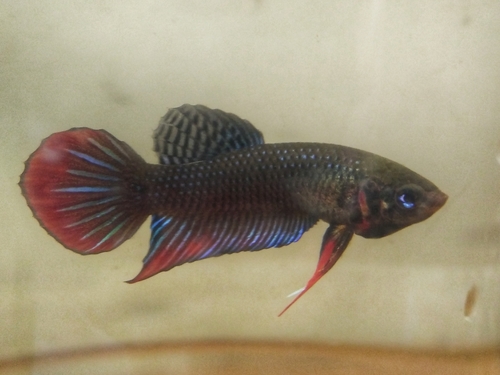
Siamese Fighting Fish
The Atlantic bluefin tuna (Thunnus thynnus) is a magnificent and highly migratory species of tuna found in the Atlantic Ocean and the Mediterranean Sea. Renowned for its size, speed, and commercial value, it plays a critical role in the marine ecosystem and is a prized catch in fisheries worldwide. It's warm bloodedness is incredibly unique.
2 3 years
Lifespan
6.5 - 7 cm
Length
Vulnerable
Conservation Status
null km/h
Swimming speed
Insectivorous
Diet
Sedentary
Migration
Appearance Overview
The Atlantic bluefin tuna is a large, torpedo-shaped fish with a metallic blue top and a silvery-white underside.
Color
Dark metallic blue on top, silvery-white underside
Body Shape
Torpedo-shaped, streamlined for speed
Fins
Two dorsal fins, the first is depressible
Finlets
Small finlets behind the second dorsal and anal fins
Length
Up to 13 feet (4 meters)
Weight
Up to 2,000 lbs (900 kg)
Diet
Carnivorous, feeding on a variety of fish, squid, eels, and crustaceans.
Feeding Behavior
Highly active predator, often hunting in coordinated schools to encircle and trap prey.
Social Behavior
Forms large schools, especially during migration, but can also be found solitary or in smaller groups.
Commercial Relevance
Extremely high value, particularly in the Japanese sushi and sashimi market, where a single fish can sell for hundreds of thousands of dollars.
Conservation measures
Subject to international fishing quotas, monitoring programs, and efforts to reduce illegal fishing. Marine protected areas also play a role.
Status
Endangered (Varies by region, some populations are considered critically endangered)
Threats
Overfishing is the primary threat, driven by high demand. Climate change and habitat degradation also pose risks.
Habitat Distribution
Depth Range
0-1,000 meters, with preferences for surface waters during migration and deeper waters at other times.
Geographic Range
Western and Eastern Atlantic Ocean, Mediterranean Sea.
Preferred Environment
Pelagic, open ocean, often associated with temperature fronts and areas of high productivity.
Reproduction and Life Cycle
Breeding Habits
Spawns in warm waters, primarily in the Mediterranean Sea and the Gulf of Mexico, with specific spawning grounds.
Development Stages
Eggs hatch into larvae, which develop rapidly, feeding on plankton. Juveniles grow quickly, eventually becoming apex predators.
Fecundity
Females are highly fecund, capable of producing up to 30 million eggs per season.
Maturity Age
Reaches sexual maturity at around 4-8 years, though this can vary depending on location and population.
Faqs about Siamese Fighting Fish
Where can Atlantic bluefin tuna be found?
Atlantic bluefin tuna are found in the Atlantic Ocean, both in the western and eastern parts, and the Mediterranean Sea.
How long do Atlantic bluefin tuna live?
They can live up to 40 years, though many do not reach this age due to fishing pressure.
How fast can Atlantic bluefin tuna swim?
They are among the fastest fish in the ocean, capable of bursts of speed up to 40-60 mph.
What's unique about their physiology?
Atlantic bluefin tuna are warm-blooded, which is unusual for fish. This allows them to maintain a higher body temperature than the surrounding water, aiding in muscle efficiency.
How many eggs do they lay?
Females can release millions of eggs per spawning season, though the survival rate of these eggs is relatively low.
Copyright @ Nature Style Limited. All Rights Reserved.
 English
English